Digital Amateur Television DXpedition to DL, F and HB9 2023
Latest update: 2023-06-12 23:00 UTC
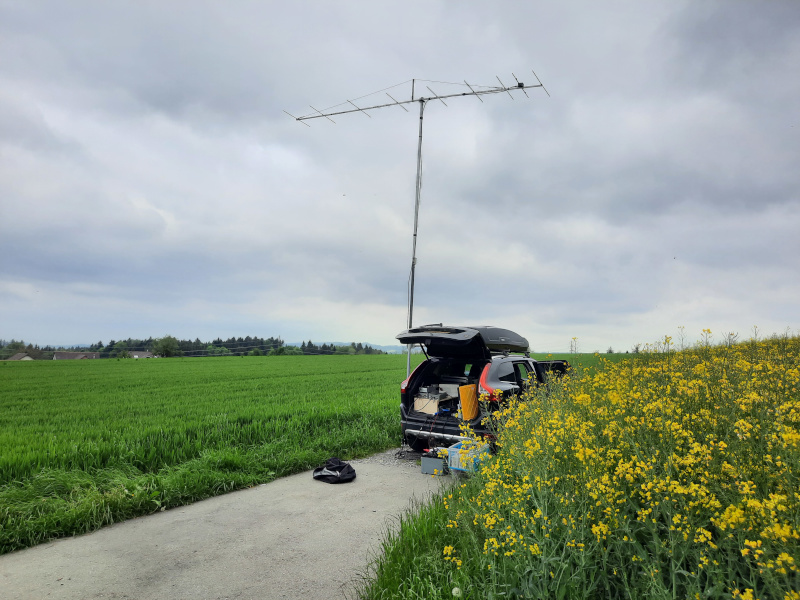
QRV on 2m as HB9/PE1ITR JN47CF (Witwil). Altitude 708m.
The global plan
Between 2023-05-18 and 2023-05-21 i will make a journey where I will visit at least the squares JN48, JN38 and JN47. Depending on the location the callsigns DL/PE1ITR, F/PE1ITR and HB9/PE1ITR will be used. I will be traveling by car and the station is also built into the car. The focus is Digital Amateur Television, DATV.
I will be QRV with reduced bandwidth amateur digital television (RB-DATV) in DVB-S(2) mode on 2m and 70cm only.
It turns out that in this mode you can easily exchange moving images, whereby large distances can be bridged by means of aircraft scatter.
Perhaps some distance records can be broken again. Ken W6HHC, maintains the record of the world DATV records here: 2022
https://w6ze.org/DATV/Known-DATV-DX-Records_2022.pdf and 2023 https://w6ze.org/DATV/Known-DATV-DX-Records_2023.pdf.
The talkback channel during operation is: https://dxspot.batc.org.uk or Zello channel "ATV Nederland".
I know that a number of stations in the Netherlands are ready to make a QSO. Feel free to contact me whenever you want a sked too. Then I will add you to the email list where I will spread the latest news.
To PA the distance will be 400 - 500 km from JN48 depending on your location. The distance to PA will be 550 - 700 km from JN47. I think this is possible with the Airplane scatter propagation.
Indicative timetable
Click here to download the timetable. <- Download Preliminary timetable
I emphasize that this timetable is only an indication as local conditions may be different.
Station
Portsdown DATV transmitter with Limesdr Mini.
144 MHz: 9 el yagi with 200w DATV. freq 144.600 MHz; Mode: DVB-S(2) symbol rate 125k of 66k.
432 MHz: 2x16 el yagi with 150w DATV. freq 436.5 MHz; Mode DVB-S(2) symbol rate 125k of 66k.
I prefer the DVB-S2 mode with an SR 125k FEC 1/2. Other settings are also possible, such as DVB-S2 with an SR 66k FEC 1/3. DVB-S2 clearly works better than DVB-S.
The receiver is a Minitiouner Express with good MF filtering. Each band has a pre-amp then convertered to a MF with filtering.
Here is an impression of the DATV 144 MHz station when I was QRV in the Dutch DATV contest from Luxembourg in august 2022: Link
This is the setup as used on this DXpedition:
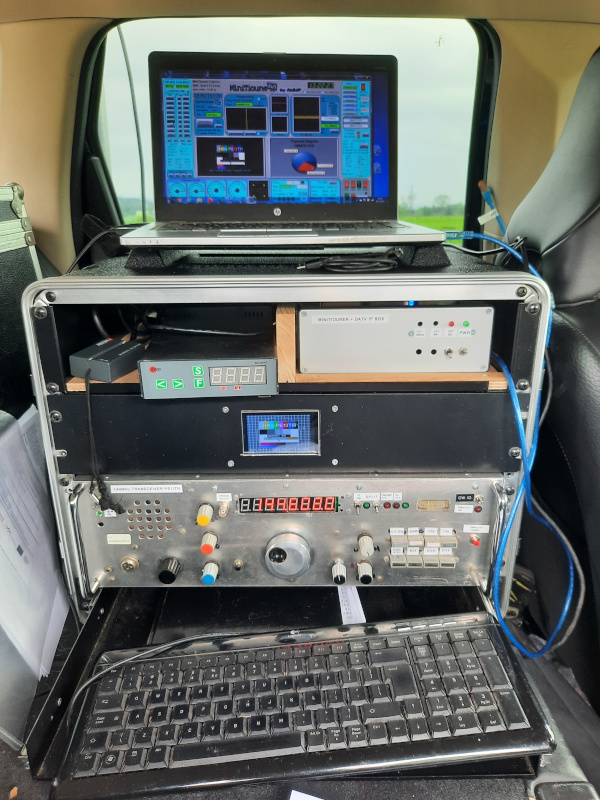
From top to botom. On top the laptop with Minitiouner software. Then left the rotor control. Right the 9 MHz filter + upconverter and minitiouner box.
Next level the Portsdown DATV Transmitter. And then the 2m/70cm receiver.
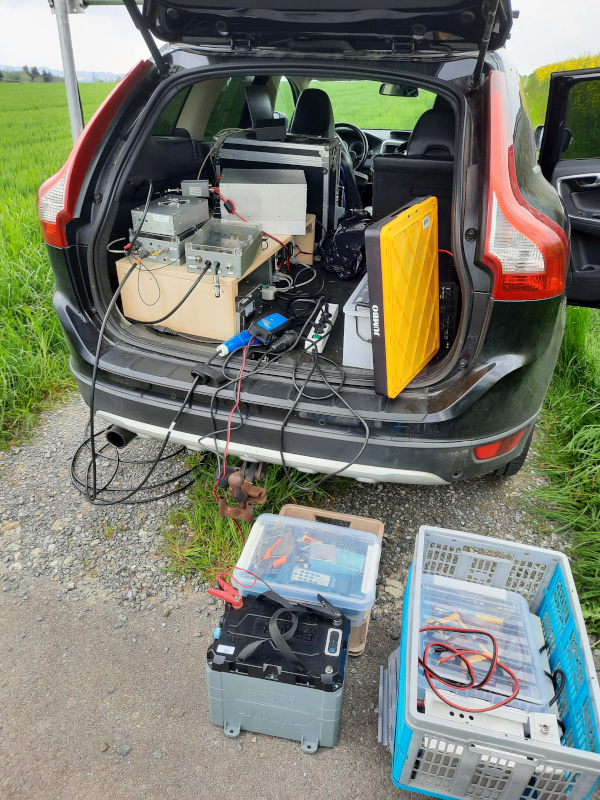
The back of the car is a mess but on the left are the pre-amp boxes and the amplifiers. The 70cm PA and the 48v power supplies are located under the wooden stand.
On the ground stuff needed or not needed on de dxpedition. In this case I am charging also my LiFePO4 battery.
Log
2023-05-18 DL/PE1ITR JN48CO
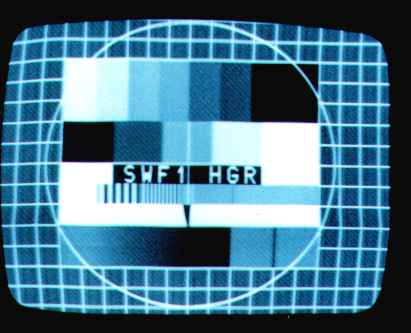
First some history. This is a picture of SWF 1 TV VHF channel 9 on the Hornisgrinde. I received this transmitter back in 1987 from JO21UL.
Special to me is that is on the same location as JN48CO.
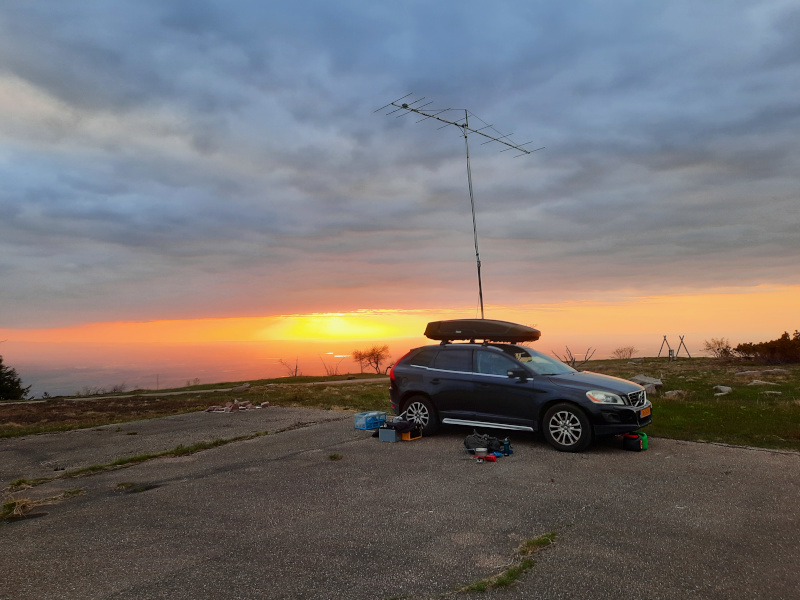
QRV on 2m as DL/PE1ITR JN48CO. Altitude 1160m
WKD:
144 MHz 18:29 UTC PI4GN JO33HJ 544km 1-way TX DVB-S 125k FEC 1/2
144 MHz 18:37 UTC ON7MOR JO21GK 409km 2-way DVB-S2 125k FEC 1/2
I was warmly welcomed by Manfred, DK1VD who guided me to the assigned place. Electricity from my gasoline generator.
Heard from several stations the signals but it was to weak for DVB video decodes. Also had 2 main RX problems because of nearby broadcast transmitters.
The first was solved by a bandfilter between antenna and pre-amp. The second was a bad coincidence because the nearby very strong DAB transmitter was on my 201 MHz IF.
PA3BYV had a partial decode of upper part of the testcard but my callsign was not on this picture.
2023-05-19 DL/PE1ITR JN48CO
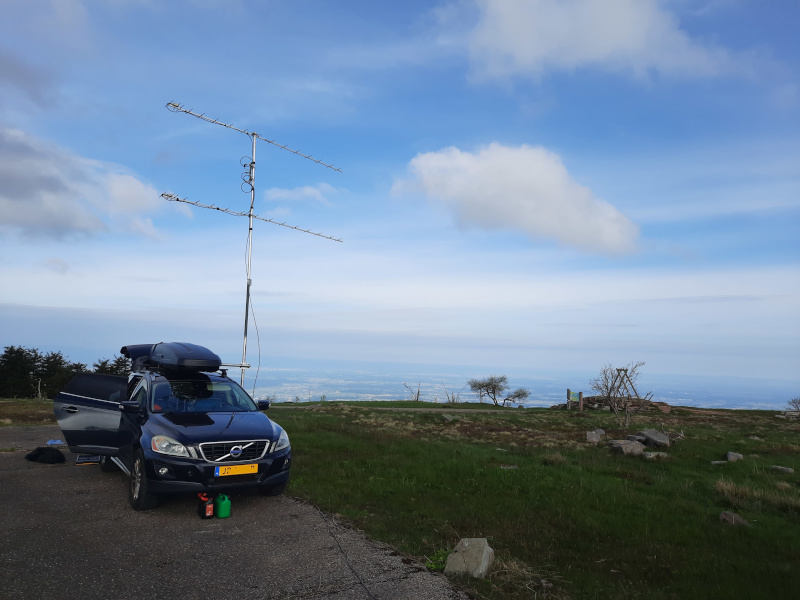
QRV on 70m as DL/PE1ITR JN48CO.
436 MHz nil
PA3BYV received signals from me. These signals were clearly visible on the waterfall display at his station, but still too weak for a decode of a picture.
2023-05-19 F/PE1ITR JN38MA
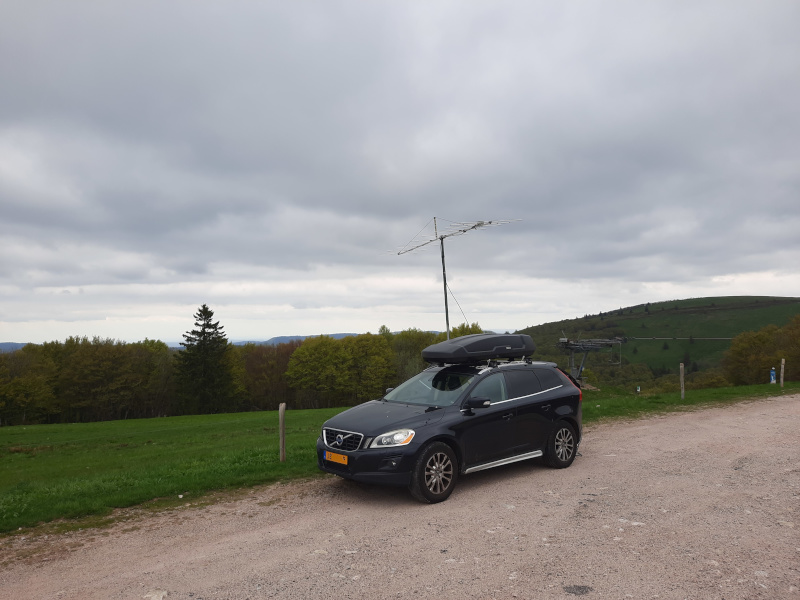
QRV on 2m as F/PE1ITR JN38MA. Altitude 1256m
WKD:
144 MHz 15:42 UTC ON7MOR JO21GK 418km 2-way DVB-S2 125k FEC 1/2
144 MHz 16:40 UTC PA0T JO33JC 565km 1-way my TX DVB-S 125k FEC 1/2
I arrived later at this location due to delays on the way. Not visible in the photo, but on arrival there were many cars parked of walkers. It was busy with day trippers.
I then decided not to build the mast completely because there was no space between the cars. Also this session I was only QRV on my LiFePO4 battery which went fine. Even with full power at 2m. At the end of the 2.5 hours I still had 20% energy left.
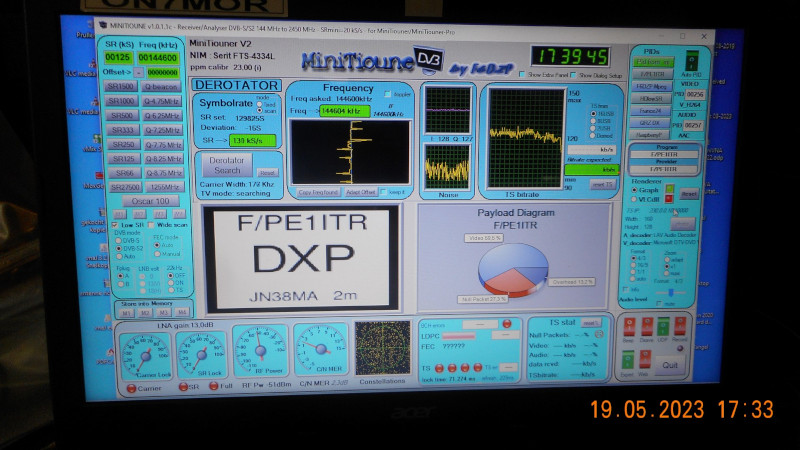
My signal as received by ON7MOR.
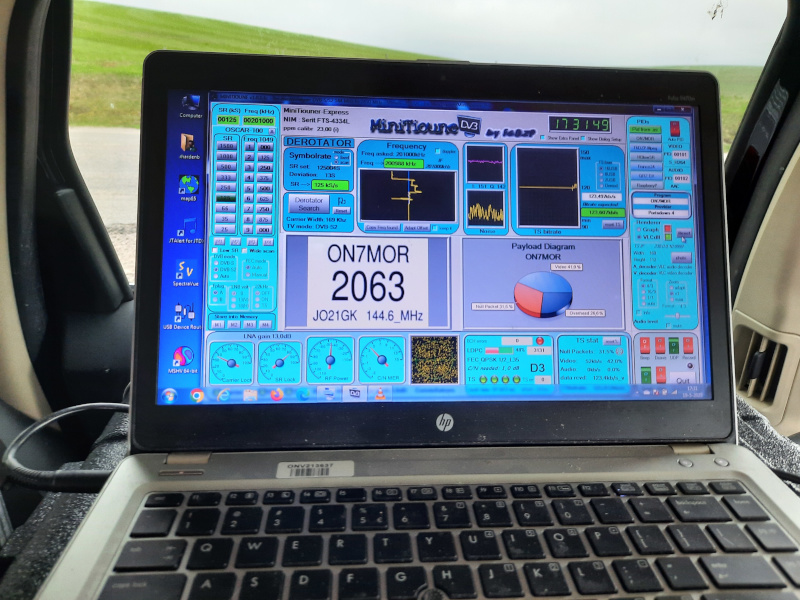
The signal of ON7MOR.
2023-05-20 HB9/PE1ITR JN47CF
WKD:
144 MHz 12:06 UTC PI4GN JO33HJ 695km 2-way DVB-S 125k FEC 1/2. D8 signal report
144 MHz 13:34 UTC ON7MOR JO21GK 539km 1-way my RX DVB-S2 125k FEC 1/2. D9 signal report
ON7MOR received a service_id and program_id from me. A D1 signal but the TS image stream was not decoded.
The 2-way QSO on 144 MHz over 695 km between HB9/PE1ITR and PI4GN is a world record distance!! The propagation was pure airplane scatter. Below are the pictures of the QSO. At the peak of the reflection, the signal strength peaked to D8. I timed the duration of aircraft reflection of the signal from PI4GN and it lasted for at least 40 seconds. It was a good agreement that aircraft reflections are more effective over long distances when the signals are incident at a small angle. In hindsight, we could have easily broadcast a video instead of broadcasting a test image.
Electricity from my gasoline generator.
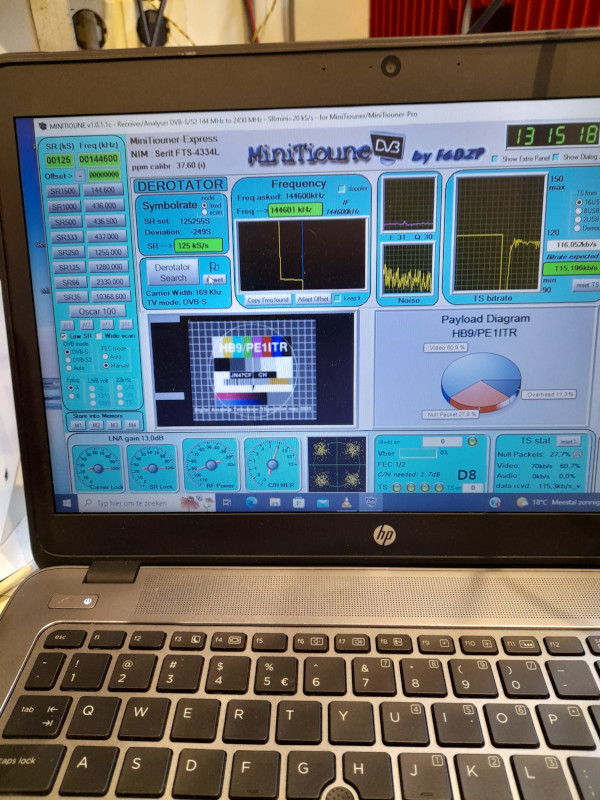
My signal as received by PI4GN.
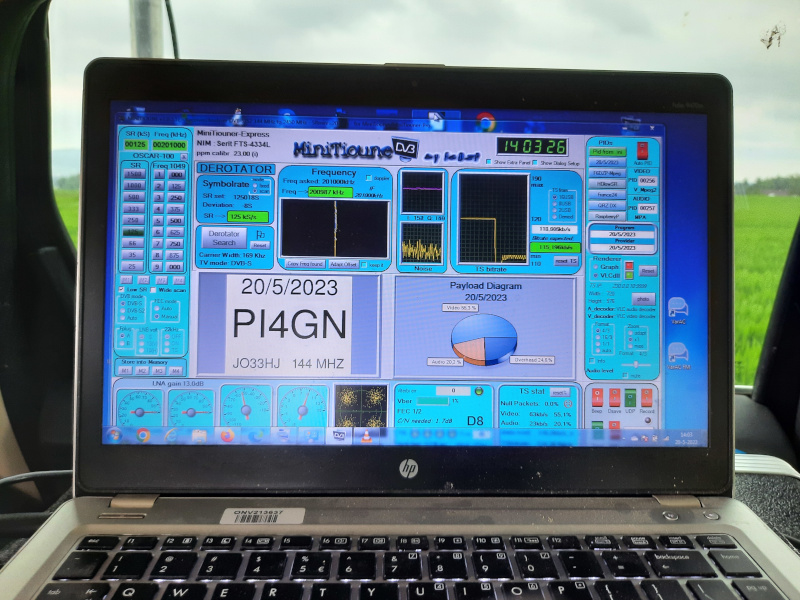
The signal of PI4GN. Here a video recording of the signal.
I have a habit of also listening to the DVB signal in 3kHz SSB bandwidth. You do not really hear a signal, but you do hear the noise of the data packets. This sound gives very useful information about the actual received signal level. When PI4GN and ON7MOR switched on the their transmitter, I could immediately hear the characteristic troposcatter signal in the 3 kHz bandwidth, while this was below the noise level of the DVB receiver. This corresponds to the red line in the graph.
The Forward Scatter Signal from the aircraft reflection that occurred at the magic moment time is according to the calculations at least 15 db stronger. The blue line indicates 4.5 db above the noise at a distance of 700 km. This is a lower value than in practice. For a D8 signal, the level must have been at least 11 db above the noise.
On the PI4GN side, a 6x9 X-pol yagi antenna system was used. This gives 7 to 8 db more gain compared to a singly yagi antenna. The graph clearly shows that those extra dB's were needed to enable a 2-way QSO over 695 km.
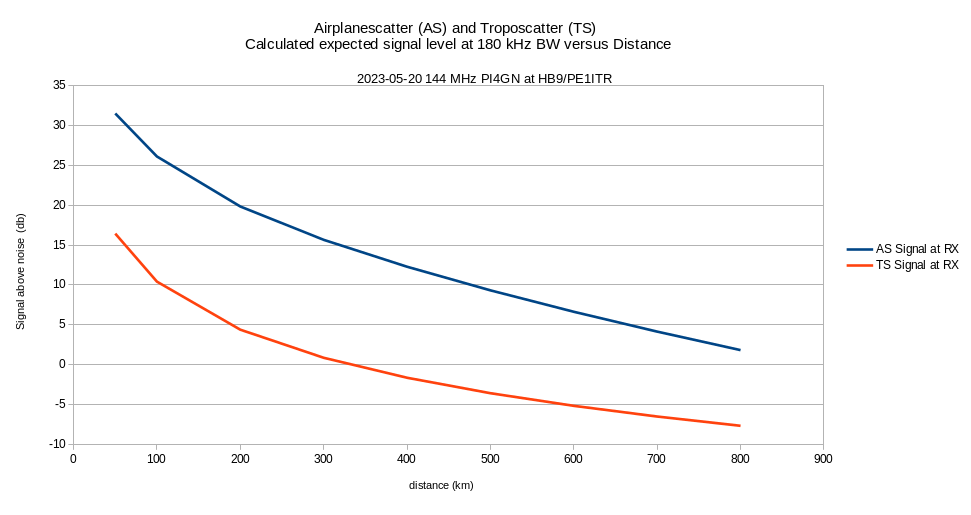
Resume
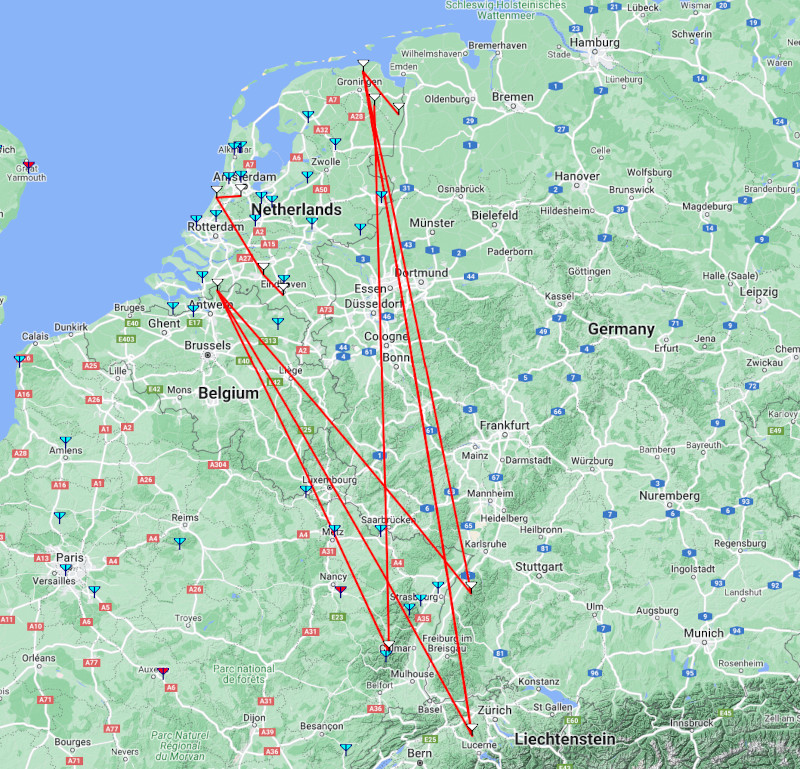
QSO map.
A full report will follow.....
Special thanks to all the stations that were QRV and wanted to try a QSO with me.
2023-05-21 DATV Moonbounce Experiment
On the last day of the DXpedition, a special experiment was planned, of which it was very uncertain whether it would succeed. 50% or less chance of success I think. The goal was to send an RB-DATV signal to the moon at 1296 MHz and then receive it back on Earth. The transmitting station was HB9Q with a 10m dish. The receiving station PI9CAM with a 25m dish.
For the occasion, I had driven to the HB9Q station. There was a warm welcome from Dan, HB9CRQ. In the preparation we had thoroughly gone through the setup and everything was ready to connect my DATV transmitter without any significant issues. We proceeded with caution... The DATV was placed near the dish and we operated outside. It was a beautiful sunny day.
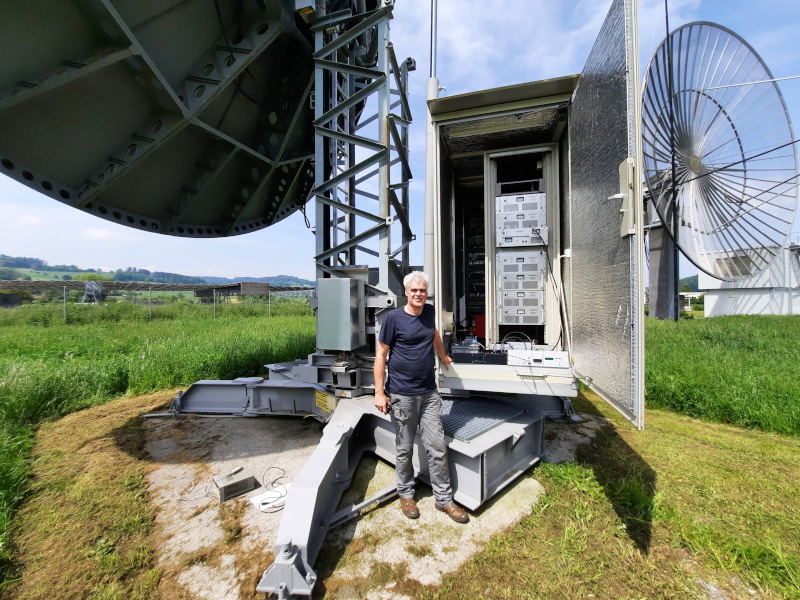
DATV Transmitter connected and ready to go.
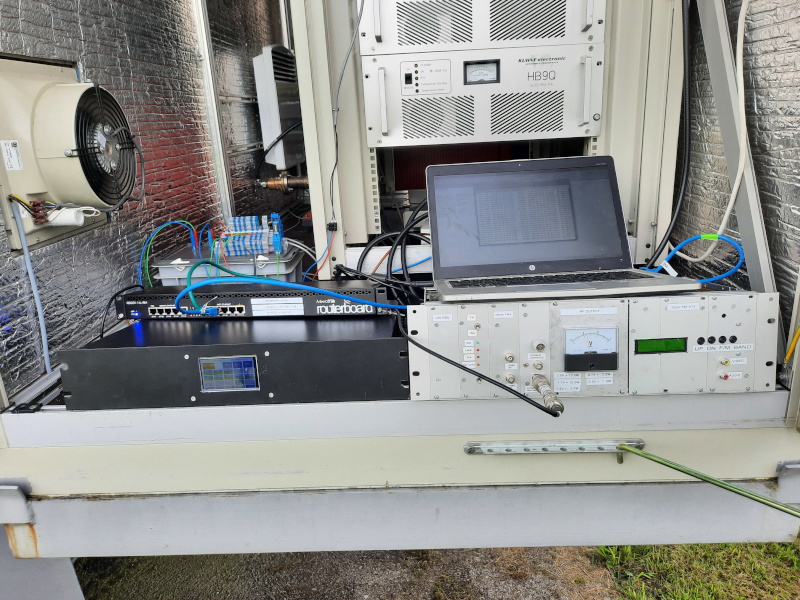
The Portsdown DATV Transmitter (left) with a 23cm driving stage (right). From here it goes on 23cm to the HB9Q cabinet.
On top an ethernet switch and laptop to drive the IPTS input of the Portsdown TX.
We have experimented with various settings for DVB-S(2) with different symbol rates from 125k down to 30k.
However, the signal level at PI9CAM was perfectly perceptible, but insufficiently strong for a decode of the video.
In addition, there are the effects of the moon reflection for which the DVB-S is certainly not designed.
In short, not a successful video transfer, but learned a lot.
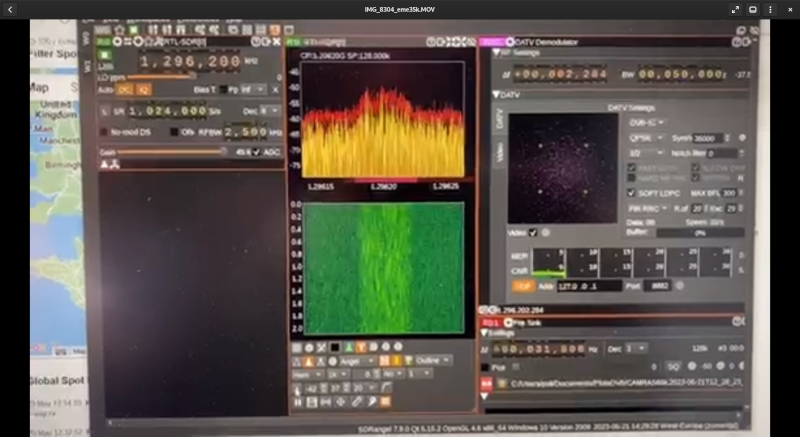
This is the signal with the 35k symbol rate signal from the moon at PI9CAM. It is about 5db above the noise.
Clearly, in more ideal conditions, a signal 1 db above noise would have been sufficient. Theoretically, we had sufficient signal strength. However, EME radio propagation has other characteristics that we need to take into account. Triggered by this fantastic experiment, go into more detail on this page.
Information
You can email me on my qrz.com address
Latest info on this website
Also on MMMonVHF
73 de PE1ITR.
HOME | Go Back













